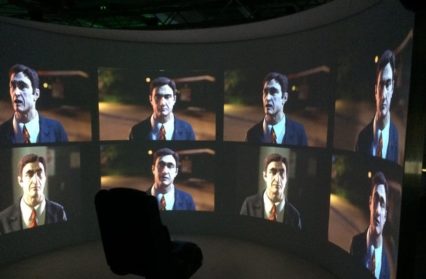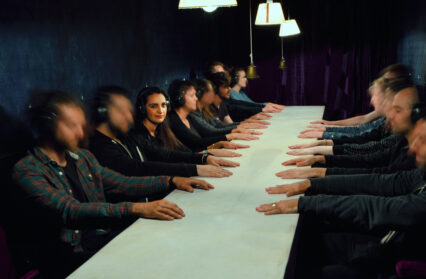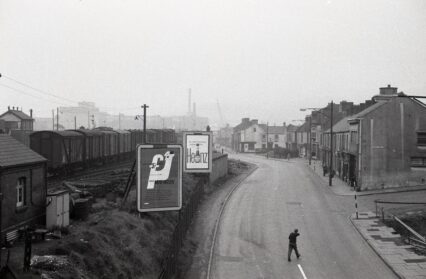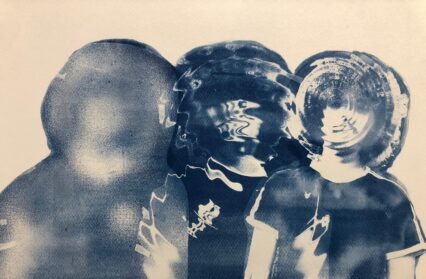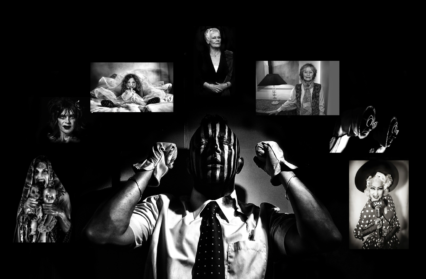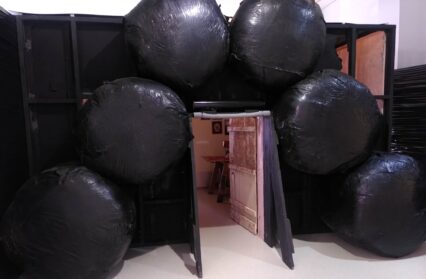Lizzie Lloyd reviews the immersive multimedia experience of Tom Cardew‘s Love Hangover at the G39 gallery in Cardiff.
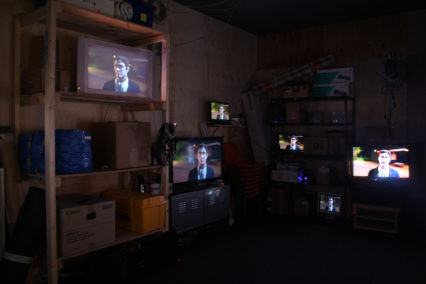
I hesitate. The words ‘Tom Cardew Love Hangover’ and an arrow on the floor of G39 Cardiff assure me that this is the way, though it feels more like the entrance to a store cupboard. At the end of a harshly lit corridor – bare wood panels standing in for walls – is floor-to-ceiling shelving filled with old bashed-up boxes, TVs, a metal bucket and piles of magazines. One of the TV sets is on. From it, a dejected-looking middle-aged face, deeply creased, lookout. He’s neatly turned out: hair cropped, combed and side-parted, wearing a blue shiny suit with a tie tied tight. His discomfort shows through though: his eyes rove, blinking frequently; the muscles of his brow twitch; the set of his lips slip between a grimace and a smile (it’s hard to tell which); he turns from side to side, his head dropping now and again as if accompanied by a heavy sigh. He might be talking to himself, though I can’t hear any words, not words that appear to belong to him anyway.
Even from a distance, it’s clear that this is a CGI face. His movements stutter unnaturally, the look in his eyes part-vacant, part maniacal. But his restlessness, his unease, lend him a humanity that I’m drawn to. It makes me worry for him alone over there, cast off in the storeroom, along with the obsolete tech stashed around him: DVD players, his own boxy monitor and such.
We’re eye-to-eye now, or nose-to-nose. To my right, the corridor continues. From it a burbling patter of voices builds. One hum – is that the Welsh national anthem? – another clears his throat. The wall of storage continues metres from it. Further along, the passageway is another version of the inscrutable CGI guy again, on a bigger screen this time, stacked among a grid of six monitors of which only his is turned on. Meanwhile, the nearby voices, that were once just fragmented rumblings, gather apace.
I turn the last corner and enter a dark room. The only light source is from a selection of the 14 monitors, variously sized, set around the room and the blue power LED of speakers from which, I now realise, the voices hail. Each monitor plays a slightly different version of the CGI guy again. He still looks depressed and world-weary but at least he’s given voice now; I’m keen to get to know him.
The dialogue – part isolated internal monologues, part snippets of a one-sided conversation, part empty office prattle – deliberately frustrates though. I learn no specifics of the CGI guy’s story; instead, I’m left with a sensation of pitiful emptiness. ‘Do you want a coffee?’ one voice asks. ‘1, 2, 3, 4, 4 coffees, yeah? 4 coffees. 5 coffees, we’re up to 5 coffees. Who’ll give me 6 coffees?’ the same voice jokes, playing at auctioneering. Another, deadpan, outlines the responsibilities of a manager: ‘One of the main attributes to management,’ he recounts painfully slowly, ‘is that you have to manage well: people, places, things, time, space… things, more things… other people with other people, people in rooms, people on the phone’. Another voice, whispering this time, describes his technique for replying to email: ‘I put in nice quotes from inspirational thinkers […] it usually takes them a while to respond to that.’ Ouch. I imagine him, a cliché, slumped at his desk, waiting for retirement to jack in his day job.
As excruciating as they are, the overall effect of these words is tenderness, humanity. It’s a familiar tale: dissatisfaction leads to boredom, and with its madness. Standing in the middle of this darkened room I wonder now if I’ve just walked into the recesses of the CGI guy’s brain, surrounded by the voices inside his head.
This space, like the corridor, feels like a backroom not intended for visitors. I make an inventory of what else is stored in here amongst CGI guy and his screens and speakers: old light projector, loose coils of electrical cables slung over hooks, a fan, old printers, plastic red chairs stacked, an IKEA bag, plastic storage boxes, one labelled ‘X-mas Decs’ on a yellow Post-It note, a football (team building activity?). CGI guy fits right in with these accoutrements of office life – a dispensable matter we hold on to just in case or wheel out for special occasions. There’s a poignancy to all this. This fictional CGI avatar, a stand-in for A.N. Other, becomes another tool of a labour force on the brink of obsolescence, set to be replaced by the younger, more cutting edge technology.
The mumblings of conversation begin to peter out, replaced by piano notes. Gradually the CGI guys break into a pared-down version of Diana Ross’s ‘Love Hangover’. In the hands of Cardew or his CGI avatar, the 1975 Motown hit takes on a looser more languorous feel. It’s like CGI guys are all listening to the same tune but in isolation, on invisible headphones. Unselfconscious and heartfelt they sing, hum and murmur breathily along, feeling their way through the notes, slightly out of tune, slightly out of time. ‘I want want want no cure cure cure for this, Love Hangover,’ they chorus, a touch of haphazard, even drunken, slippage bringing them together and apart again.
Cardew handles his avatar with humour but also sensitivity. Importantly, he doesn’t characterise the digital as unreal, pitting it against an idealised version of the human. This digital figure, like the installation as a whole, is full of foible: disorganisation, embarrassment, awkwardness, melancholy. It’s genuinely touching. I’m struck by how much I warm to, even empathise with, the various iterations of this depressed white office worker in the throes of a mid-life crisis. Like Ricky Gervais’ David Brent, CGI guy makes me wince. But beneath his desperation to communicate, to impress, to befriend, is a sense of ultimate insignificance that feels familiar. It’s the small things that get us through though, singing along to our favourite tune, say. One by one the screens turn black in time with the music, Love Hangover fades out and I emerge from the storeroom slash exhibition, humming to myself.
Love Hangover, an exhibition by Tom Cardew is on at G39 in Cardiff until July 13th.


